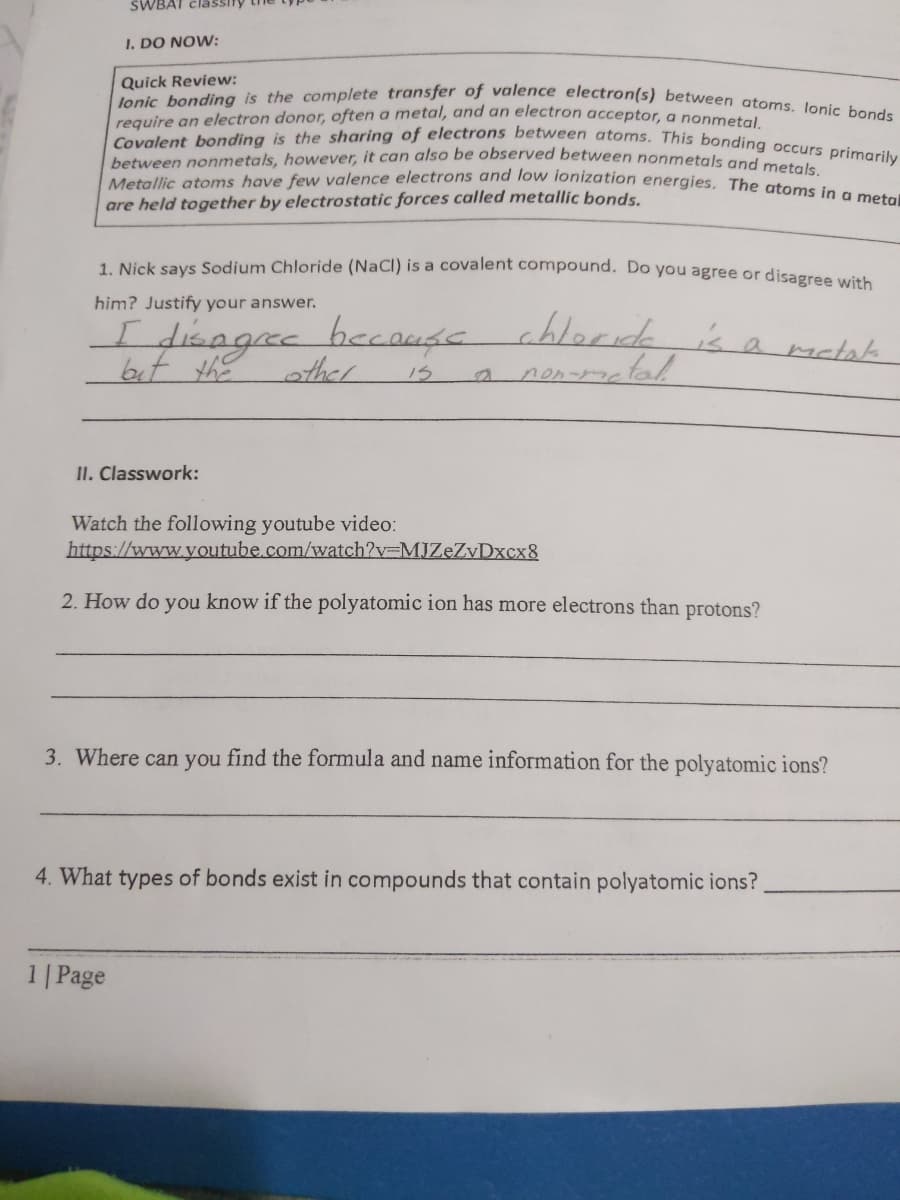Principles of Modern Chemistry
8th Edition
ISBN:9781305079113
Author:David W. Oxtoby, H. Pat Gillis, Laurie J. Butler
Publisher:David W. Oxtoby, H. Pat Gillis, Laurie J. Butler
Chapter3: Atomic Shells And Classical Models Of Chemical Bonding
Section: Chapter Questions
Problem 99AP: A stable triatomic molecule can be formed that contains one atom each of nitrogen, sulfur, and...
Related questions
Question
How do you know if the polyatomic ion has more electrons than protons

Transcribed Image Text:Metallic atoms have few valence electrons and low ionization energies. The atoms in a metal
ŚWBAT clas
Covalent bonding is the sharing of electrons between atoms. This bonding occurs primarily
lonic bonding is the complete transfer of valence electron(s) between atoms. lonic bonds
1. DO NOW:
Quick Review:
aguire an electron donor, often a metal, and an electron acceptor, a nonmetal
between nonmetals, however, it can also be observed between nonmetals and occurs
are held together by electrostatic forces called metallíc bonds.
1. Nick savs Sodium Chloride (NaCl) is a covalent compound. Do you agree or disagree with
him? Justify your answer.
shlorık
disngee hecauge
but the
sa metak
ather
15
non-me
II. Classwork:
Watch the following youtube video:
https://www.youtube.com/watch?y-MJZeZvDxcx8
2. How do you know if the polyatomic ion has more electrons than protons?
3. Where can you find the formula and name information for the polyatomic ions?
4. What types of bonds exist in compounds that contain polyatomic ions?
1| Page
Expert Solution
This question has been solved!
Explore an expertly crafted, step-by-step solution for a thorough understanding of key concepts.
Step by step
Solved in 2 steps

Knowledge Booster
Learn more about
Need a deep-dive on the concept behind this application? Look no further. Learn more about this topic, chemistry and related others by exploring similar questions and additional content below.Recommended textbooks for you

Principles of Modern Chemistry
Chemistry
ISBN:
9781305079113
Author:
David W. Oxtoby, H. Pat Gillis, Laurie J. Butler
Publisher:
Cengage Learning



Principles of Modern Chemistry
Chemistry
ISBN:
9781305079113
Author:
David W. Oxtoby, H. Pat Gillis, Laurie J. Butler
Publisher:
Cengage Learning



Chemistry for Engineering Students
Chemistry
ISBN:
9781337398909
Author:
Lawrence S. Brown, Tom Holme
Publisher:
Cengage Learning

Chemistry & Chemical Reactivity
Chemistry
ISBN:
9781337399074
Author:
John C. Kotz, Paul M. Treichel, John Townsend, David Treichel
Publisher:
Cengage Learning

Chemistry & Chemical Reactivity
Chemistry
ISBN:
9781133949640
Author:
John C. Kotz, Paul M. Treichel, John Townsend, David Treichel
Publisher:
Cengage Learning